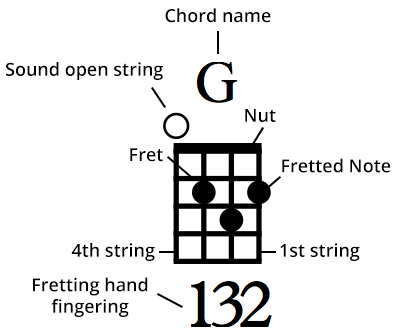Baritone Chord Library
Figure out how to play baritone ukulele chords in a variety of positions across the fretboard. Select a chord below to get the baritone chord diagram.
How to Read Baritone Chord Diagrams
Not sure how to read the baritone chord diagram above? Not a problem.
A chord diagram is designed to look like a ukulele fretboard, as if the ukulele was positioned in a vertical, upright position.

The top thick black bar represents the nut of the ukulele.
From left to right, the four vertical lines represent the strings of the baritone ukulele (D-G-B-E). The 4th string is the top D-string, 3rd string the G-string, 2nd string the B-string, and 1st string the bottom E-string.
The thinner horizontal black lines indicate the frets of the ukulele.
The black filled-in circles represent the spot where you position a finger to play a chord. The open, empty circles indicate strings in the chord that ring completely open.
The numbers below the chord diagram indicated a suggested fingering for the chord. The number 1 indicates the index finger, number 2 the middle finger, number 3 the ring finger, and number 4 the little finger. Keep in mind these are just suggested fingerings. You might find a different or easier way to position your fingers for a ukulele chord.
For example, select a “G major” chord. The chord diagram indicates you place your ring finger (number 3) on the 3rd fret of the E-string. The other strings ring open.
Not sure how to identify the parts of the ukulele (nut, frets, strings, etc.)? We got you covered. Read this helpful lesson on the parts of the ukulele here.
